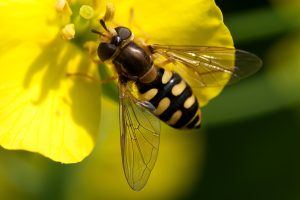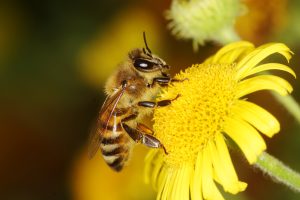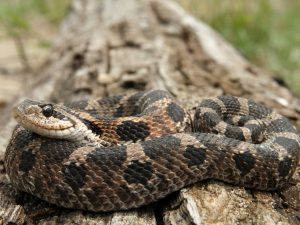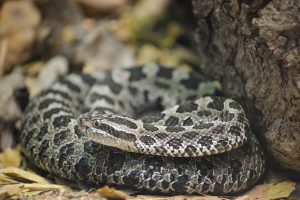It may buzz like a bee, it may have black and yellow stripes like a bee, but this insect is actually a fly! If you look closely, you’ll notice that the hoverfly has much larger eyes than a bee or wasp, taking up most of its head. Hoverflies also have one pair of wings while bees, wasps, and hornets have two pairs. The hoverfly’s antennae are also very short, and its body isn’t fuzzy. Most noticeably, hoverflies can’t sting!
But if they can’t sting, why do they look so much like bees and wasps? Stinging insects like bees and wasps often have similar bright yellow and black stripes as a warning for predators: don’t attack me, I’ll sting you! When species that are similarly harmful to predators develop the same appearance or behavior, this phenomenon is known as Müllerian mimicry. Some animals, like hoverflies, copy another animal’s warnings to trick predators into thinking they’re harmful as well, even though they don’t have the same defenses. This is known as Batesian mimicry. While hoverflies aren’t bees, they are still pollinators, and their larvae eat garden pests called aphids, making them helpful to gardeners and farmers.
Fun fact: Bright colors and patterns meant to warn predators of an animal’s sting, poison, or bite, such as the bee’s black and yellow stripes, are called aposematic coloration.
Eastern Hognose Snake
With its keeled scales and brown or gray striped body, the eastern hognose snake resembles Michigan’s only venomous snake, the eastern massasauga rattlesnake. However, the eastern hognose snake is not venomous and isn’t aggressive toward humans. It does have a few defenses to deter predators. First, it will puff up its neck like a cobra. Second, it will hiss and perform a quick headbutt motion but won’t bite. Finally, if that doesn’t work, it will roll over, open its mouth, and play dead. It will also release a smelly substance called musk, making it taste bad to predators.
Fun fact: Hognose Snakes get their name from their upturned piglike snouts.
Written by: Cameron Howell – Potter Park Zoological Society Intern
Nearly 500 animals call Potter Park Zoo home, including critically endangered black rhinos, endangered red pandas, Massasauga rattlesnake and spider monkeys. The zoo is located in Lansing, Michigan, and is open 364 days a year. For more information, visit www.potterparkzoo.org.







